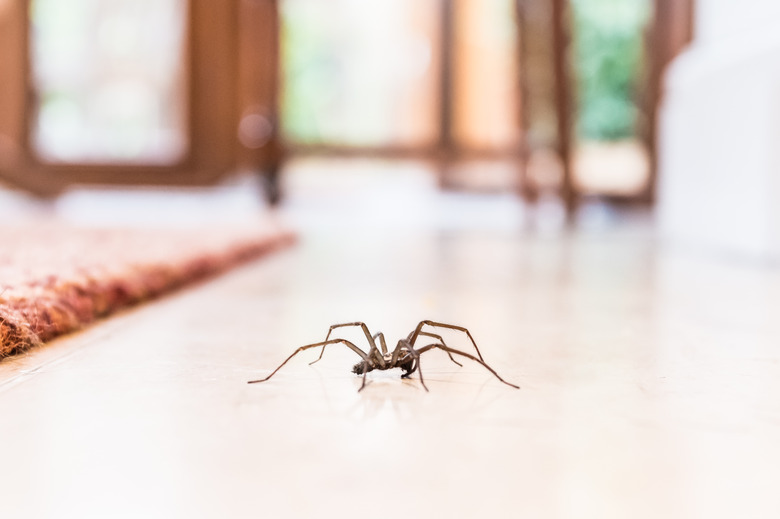Common House Spiders And Their Mating Habits
Common house spiders usually build their webs in the corners of garages, basements, attics, and other dark, little-used areas. Common house spiders are not harmful to humans, although the hobo spider's bite is painful. Mating habits vary from species to species, but the lifespan of the adults is usually around one year.
Common House Spider
Common House Spider
Parasteatoda tepidariorum, the common house spider, is also known as the American house spider. Female common house spiders are not aggressive towards the male, and it is usually she who initiates mating. Often, male and female house spiders will live together on the same web. The spiders occupy the underside of the web, hanging upside down. When the female is ready, she signals to the male, sometimes by plucking the web or by shaking her legs in the air. The female may mate with a number of different males, or several times with the same male. Mating can occur at any time of year. Common house spiders deposit as many as 250 eggs into a sac of silk. These sacs are often brown in color and are flask-like in shape. Females produce up to 17 of these sacs during a lifetime, resulting in more than 4,000 eggs. Within a week, spiderlings hatch. Adult specimens may survive for more than a year.
Brown House Spider
Brown House Spider
The cupboard or brown house spider, lives in numerous locations around the world and resides mostly in dark, dank areas such as:
- basements
- crawl spaces
- garages
Brown house spiders are typically less aggressive than other spider species, but their body shape is similar to a black widow, with a bulbous abdomen and thin legs. Their webs are tangled and sticky. Male brown house spiders reach up to six millimeters (1/5 of an inch), while females may grow to exceed 10 millimeters (1/3 of an inch). Their webs serve as mating and breeding grounds. Mating takes place at any time of year, with the males and females mating within the web. The male may die soon after breeding.
Domestic House Spider
Domestic House Spider
The domestic house spider, Tegeneria domestica, is often confused with the hobo spider, although it is slightly smaller. In North America, it also goes by the name of barn funnel weaver. It has a brown body with striped legs and small circles on the abdomen. The females grow up to 10 millimeters (1/3 inch) and the males 6 millimeters (1/5 inch). Females lay large clusters of eggs, up to nearly 50. Spiderlings hatch from the egg sac, and disperse. The domestic house spider's web consists of a flat part that ends in a funnel retreat. These spiders mate any time of the year and typically live one year.
Hobo Spider
Hobo Spider
Hobo spiders have brown bodies and long thin legs, and are 12 to 18 millimeters in length (1/2 inch to 3/4 inch). Both male and female hobo spiders have two short "arms" between their front legs, called pedipalps. The male's pedipalps are used to transfer sperm to a female. Male hobo spiders are likely to be found looking for mates in human dwellings in the late summer and autumn. Once mated, the female lays batches of eggs inside silken egg cases secured in well-hidden spots. Spiderlings hatch from the eggs, but remain in the case for the first few molts. Spiderlings molt several times and must shed their skins to grow.
Giant House Spider
Giant House Spider
The largest arachnid of its genus, the giant house spider, Tegenaria gigantica, is also known as the greater European house spider. It can reach up to 18 millimeters (3/4 inch) in size, is brown in color, and its bite, though painful, is not a threat to humans. Similar to hobo spiders, they have pedipalps that, in the male, transfer sperm to the female. They seek mates during the late summer and autumn, and can often be found in human dwellings.
References
- "Insects and Spiders of the World"; Robert S. Anderson, Richard Beatty, Stuart Church; 2003
Cite This Article
MLA
North, Meg. "Common House Spiders And Their Mating Habits" sciencing.com, https://www.sciencing.com/common-house-spiders-mating-habits-6802490/. 22 November 2019.
APA
North, Meg. (2019, November 22). Common House Spiders And Their Mating Habits. sciencing.com. Retrieved from https://www.sciencing.com/common-house-spiders-mating-habits-6802490/
Chicago
North, Meg. Common House Spiders And Their Mating Habits last modified March 24, 2022. https://www.sciencing.com/common-house-spiders-mating-habits-6802490/
